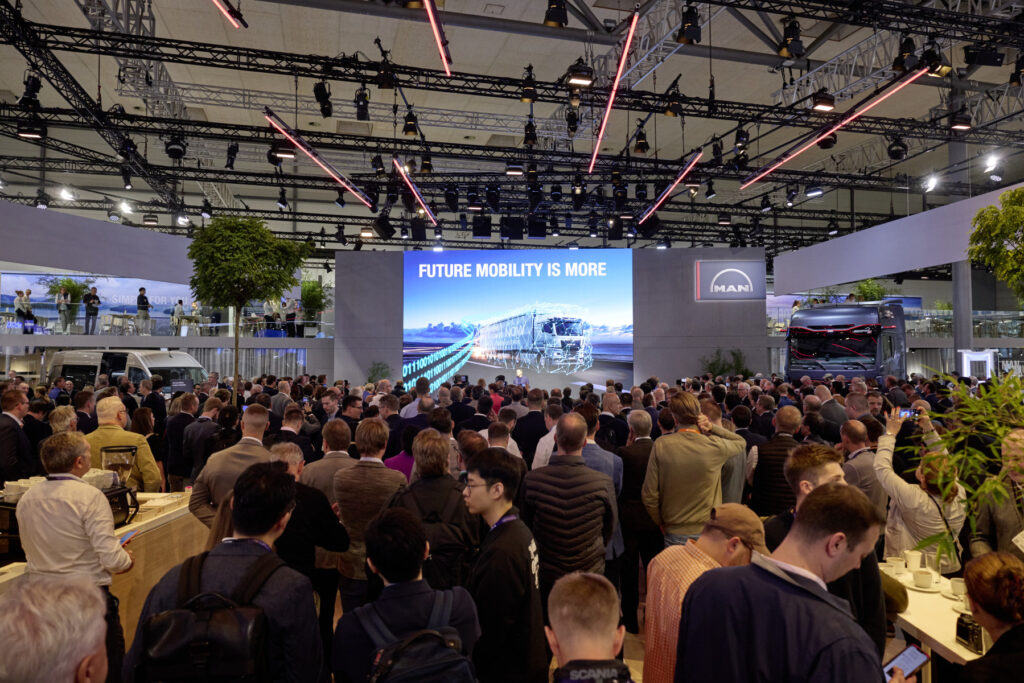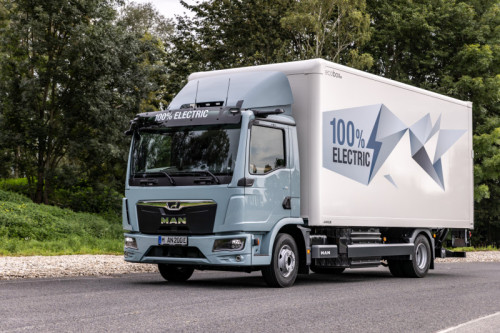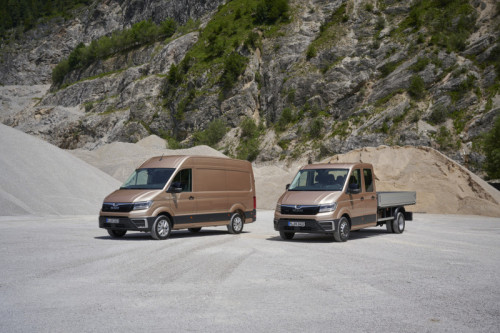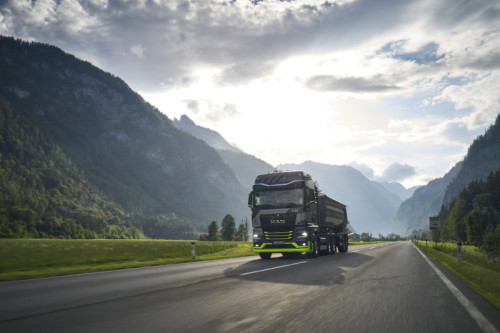The decarbonisation of road freight transport is the focus of MAN Truck & Bus’ appearance at the IAA Transportation 2024. The trucks with electric, hydrogen and state-of-the-art diesel drives on display in Hall 12, Stand C04, are representative of the company’s innovative and sustainable transport solutions.

As a driver of sustainability in the transport sector, MAN is entering a new era at the IAA 2024: under the motto “Simplifying Business”, the company is showcasing its entire truck drive portfolio with electric, hydrogen and diesel technology for the first time. This includes a world premiere with the MAN eTGL: the electrically powered 12-tonne truck rounds off MAN’s electric truck portfolio with light distribution transport at the bottom end. With the eTGL, MAN now offers its customers a complete portfolio of electric trucks from twelve to 50 tonnes – including the associated consulting and services, which will also be presented.
The MAN hTGX hydrogen combustion engine complements the zero-emission portfolio for special applications. MAN will be the first European truck manufacturer to launch a small series with a hydrogen combustion engine from 2025.

The innovations in conventional diesel drives for MAN semitrailer tractors from model year 2025 will focus on reducing fuel consumption and CO2 emissions by up to 4 per cent. This is made possible by the highly efficient, completely newly developed PowerLion drivetrain with the new D30 engine, which is based on the TRATON GROUP’s shared component platform, the new MAN TipMatic 14 gearbox and aerodynamic measures.
Electromobility is the main drive technology for MAN Truck & Bus
“Even though the transition to CO2 -free freight transport is characterised by several drive technologies, our focus is clearly on electromobility as the main drive technology,” says Alexander Vlaskamp, CEO of MAN Truck & Bus. “The hydrogen burner can be a useful addition for special applications, as can the fuel cell drive, which is currently still under development. In addition, the diesel drive will continue to play an important role throughout the entire transformation until it is completely replaced. That is why we have made it even more efficient, economical and lower in CO2 emissions with our completely newly developed PowerLion drivetrain and the new D30 engine. It is based on the TRATON GROUP’s joint engine platform and is the tangible result of intensive collaboration between our development departments. At MAN, we manufacture combustion and electric trucks on the same series production line, which allows us to react flexibly to the shift in demand towards electric trucks. However, for the drive transition to succeed, the expansion of the charging infrastructure must be an absolute priority for politicians, infrastructure operators and manufacturers.”

eTGL celebrates its world premiere at the IAA
MAN Truck & Bus is presenting the new MAN eTGL for the first time at the IAA 2024. The electrically powered 12-tonne truck rounds off the MAN electric truck portfolio for light distribution transport. With a range of up to 235 kilometres, fast charging in around 30 minutes and a payload of up to 6,600 kilograms, depending on the body, it offers the ideal combination for quiet and locally CO2 -free transport in urban goods logistics for food chains, retailers or the catering industry. Together with the eTGS and eTGX, MAN now offers the entire total weight portfolio from twelve to 50 tonnes fully electrically with the new eTGL. Comparatively low range requirements, the option of depot charging at logistics locations and increasing noise and emission restrictions for combustion-powered trucks in city centres make urban distribution transport an important starting segment for the switch to electromobility. The MAN eTGL considerably expands the already countless eTruck configuration variants.
MAN’s eTruck portfolio grows significantly
The “heavy” brothers of the eTGL – the MAN eTGX and MAN eTGS – are fit for the requirements of all relevant industries, body solutions and transport tasks. With their three, four, five or six modularly combinable and variably positionable batteries, the 18- to 28-tonne MAN eTGX and MAN eTGS chassis with their optional 333, 449 or 544 electric hp offer customers even more flexibility. MAN is also presenting a battery layout with a seventh high-voltage battery for the MAN eTGX 6×2 chassis for the first time at the IAA. With a capacity of 623 kWh (560 kWh usable), this seventh battery significantly increases the range once again: depending on driving style, this results in a range of around 650 km without having to recharge. The additional battery power can of course also be used to operate auxiliary units. The seventh battery is installed by MAN Individual.

The MAN eTGX and MAN eTGS are being prepared for the upcoming MCS megawatt charging standard with up to 1000 kW, which enables recharging during the driver’s break from driving. This enables a daily range of up to 800 kilometres in the configuration with six batteries, which is also sufficient for typical long-distance transport applications. This is one of the reasons why customer interest is already high: around 2300 enquiries and orders have already been received, including a major order from France for 100 vehicles.
Investments in charging parks and charging stations
In addition to competitive BEV vehicles, the charging infrastructure plays a decisive role in the ramp-up of electromobility. The charging infrastructure joint venture Milence, in which MAN is involved as part of the TRATON GROUP alongside Daimler Truck and Volvo Trucks, recently opened one of the first large truck charging parks in the port of Antwerp. A total of 1700 charging points are to be created over the next few years on the manufacturers’ own initiative. A total of 50,000 will be needed by 2030 for the continuously increasing number of electric lorries.
As part of their new partnership, the energy company E.ON and MAN Truck & Bus will be setting up around 170 locations across Europe with around 400 charging points for the public charging of electric trucks. E.ON and MAN are investing in the new charging locations, which are being built along the existing MAN service network and where commercial vehicles from other manufacturers can also charge publicly. Around 125 locations are planned in Germany alone. This will create the largest nationwide public charging network for heavy commercial vehicles in the country to date. E.ON and MAN are building further locations in Austria, the UK, Denmark, Italy, Poland, the Czech Republic and Hungary, for example. E.ON has already put two charging points into operation at the MAN Service site in Berlin-Wildau, and two further sites (Karlsfeld and Fürstenwalde) are about to be commissioned just a few months after the announcement.
MAN is the first manufacturer to launch trucks with hydrogen combustion engines
In parallel to the ramp-up of electromobility, MAN is working on hydrogen technology as a complementary zero-emission solution for special applications such as heavy transport or for areas where charging infrastructure is difficult to realise. At the IAA, MAN is presenting the prototype of a hydrogen combustion truck, which will be delivered to customers in Germany, the Netherlands, Norway, Iceland and selected non-European countries for the first time as the MAN hTGX in a small series of initially 200 vehicles from 2025. Just like its electric counterpart, it fulfils the strict criteria as a zero-emission vehicle.
Highly efficient conventional drive in transition
With the new PowerLion drivetrain, MAN is launching a highly efficient engine for the MAN TGX and TGS semitrailer tractors to meet the continuing demand for conventional combustion-powered trucks in the technological transition to zero-emission drives. The engine, developed specifically for MAN vehicles on the basis of the TRATON GROUP’s bundled technological expertise, achieves a considerable further fuel reduction and thus a CO2 reduction of up to 4 per cent with the MAN TipMatic 14 gearbox, which is also new, a new generation of brakes and aerodynamic measures. Over the entire service life of the vehicle, this results in an estimated cost saving of over 20,000 euros at current diesel prices and a saving of up to 35 tonnes of CO2. In countries with a CO2 toll, it will also be able to offer further savings on kilometre costs by classifying them in very favourable toll categories.
State-of-the-art safety and assistance systems
In addition to decarbonisation technologies, the focus at the IAA is on new assistance systems. While MAN has been producing the pedestrian and cyclist detection system, the third generation of the EBA emergency braking assistant and the turning assistance system to protect the most vulnerable road users for its truck series in series production since the beginning of 2024, the new version of the MAN TGE van with a wide range of new safety and assistance functions was presented at the Transpotec trade fair in May. These included the Cruise Assist Plus system with the Emergency Assist function. The emergency assistant continuously monitors the driver’s activity. If this fails to materialise, the system can bring the vehicle to a standstill and then secure it (activate hazard warning flashers, issue eCall, unlock doors).
MAN with sustainable stand construction at the IAA 2024
The decarbonisation of road freight transport is the focus of MAN’s presence at the IAA Transportation 2024. The concept of sustainability is also reflected in the design of the MAN stand in Hall 12. Reusable materials, which are returned to the cycle after the event, play a key role in the stand construction. In this way – in the spirit of the circular economy and for long-term value creation – waste is minimised and the life cycles of products and materials are extended. For example, aluminium, carpet tiles, wood and glass are used for stand fittings instead of laminate and plastic. Printed materials are reduced to a minimum and stand personnel wear paper name badges.
The structures will be stored after the IAA and used for other trade fairs. Most of the furniture and plants are rented. Purchased plants will be planted at MAN’s Munich site or set up in offices after the IAA. A precise calculation should ensure that no food is left over at the end of the day. However, if not all of the planned rations have been eaten, they will be donated to the food bank and not thrown away. Meals and snacks are handed out in paper packaging, drinks are served in cups and glasses instead of paper cups. Each MAN crew member is given a refillable water bottle, which is topped up at the water tap station.